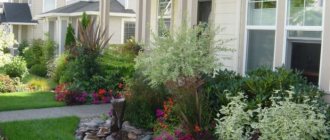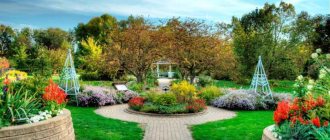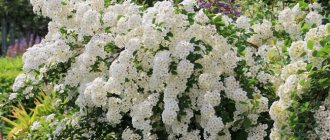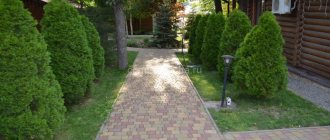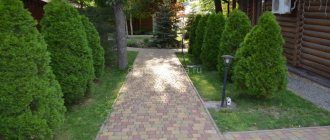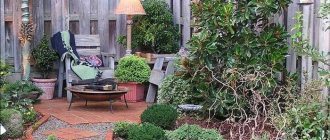About the origin of the style
Minimalism in landscape design was a consequence of the architectural avant-garde that emerged at the beginning of the 20th century, when, simultaneously with major social changes, creative techniques began to change rapidly. In contrast to the luxury of past eras, new trends are based on new principles: clarity of forms, specificity of ideas, limited color palette.
The first avant-garde movements - constructivism and functionalism - abandoned the classical canons and traditional materials. Minimalism, which took shape a little later, retained their compositional laconicism, but at the same time, moved away from overly strict rationality, and therefore was able to spread - first in architecture and interior design, and then in landscape design.
Solution for a small area Source rutimge.pw
Another factor contributing to the spread of minimalist techniques in the design of suburban areas is associated with its versatility. If the garden area is of modest size, it can be difficult to choose the appropriate style for the plot; minimalism not only fits into a small space, but also visually expands it. On a large site, creating a coherent composition using this style is much more difficult; Plants scattered over a large area can cause a feeling of emptiness and extra space.
Color palette
One of the principles of minimalism speaks of the superiority of form over quantity and color. Therefore, gardens designed in a minimalist style are characterized by discreet and not bright colors. When choosing various design elements, it is preferable to use light shades of green, beige, white, silver and terracotta. Bright accents, if present, are no more than 2-3 pieces. Subdued tones will give your garden a feeling of comfort and harmony.
Accessories
Without accessories, not a single style of landscape design is possible, and the design of a site is impossible even without the use of any style. There should not be too much decor, no frills, only light accents. In different parts of the garden you can install any abstract figures, boulders of unusual shapes, mirrors, balls or lamps, containers for plants - cylinders and cubes of different sizes. Garden stairs are also an important decorative element: from traditional rectangular steps to triangular steps, arranged in a spiral or offset to the side. The highlight is the original lamps in the form of metal balls, mirrors and installation.
Lamps and furniture
Furniture. When choosing chairs, tables, loungers and other pieces of garden furniture, give preference to the simplest, most uncomplicated options, made from simple materials without unnecessary texture.
Small architectural forms. Pergola, canopy, gazebo or veranda. It is better to combine buildings in the garden - a veranda with a platform under a canopy or a gazebo with a barbecue. As for the design of buildings, you should rely on the overall composition, everything should be combined.
If the area does not allow you to separate various decorative elements, install them side by side, but arrange the picture so that it looks holistic and as neat as possible.
Plants used
The key to creating a truly minimalist garden is the correct selection of plants, the appearance of which should also be minimalist. Plants help soften the geometry of the style, bring a feeling of comfort and a feeling of freshness.
You should not overuse brightly colored or brightly flowering plants; you should give preference to greenish-blue tones. Of course, this does not mean that beautifully flowering plants are denied access to a minimalist garden. You can choose a specific color that will add an accent, but then all other plants should be chosen in the same color scheme. Among the beautifully flowering and decorative deciduous shrubs, plants such as rhododendron, forsythia, snowberry, spirea, and viburnum Buldanezh will fit perfectly into a minimalist garden.
Plants with a restrained color scheme can be chosen from the following: blue or silver spruce, thuja, juniper, columnar apple and maple, weeping birch, decorative willow. Large trees serve as the backdrop of the garden. Medium-sized and small trees and shrubs complement differences in relief or are planted in multi-level compositions.
As for flowering perennials, any decorative grasses, hostas, ferns, Rogers, sunflowers, sedges, buzulnik, cuffs are suitable. Flowers are designed to soften the corners of decking and paving.
Special fills of gravel or stones will help solve the problem of trampling of lawns. Also for such places you can use ground cover plants that create a dense carpet: various mosses or low-growing plant species with small foliage, tenacious, mossy saxifrage, Rubra plantain, young, lemon-scented thyme.
In minimalism in landscape design you can often find vertical gardening. Suitable for these purposes: virgin grapes, actinidia. Special structures for climbing plants are not built; branches are sent along existing buildings.
As for flower beds, it is advisable to decorate them in one color scheme, selecting 2-3 plant varieties for this. And you can’t plant plants in disarray, mixed up. For a flower garden, it is better to select plants of the same species or with inflorescences of a similar shade.
Style features
Minimalism is recognized by the following features:
- Space . The strict selection of details creates a feeling of airiness of space.
- Layout . The zones are distinguished quite clearly. At the same time, strict adherence to symmetry when zoning is not required; often they abandon it altogether.
- Simplicity and geometric completeness of lines.
- Refusal of excessive diversity . This applies to everything: plants, small architectural forms, garden decor, color and furniture.
Zoning using height differences Source pinterest.com
- End-to-end zoning . Unlike other style trends, the site is divided into zones conditionally and resembles a studio apartment. For zoning, simple means are used that do not visually divide the territory - gabions, containers with flowers or paths. A good way is to separate using height differences, for which decking is ideal.
- Content . Once upon a time, in the ideas of modernism, the house and the space around it were called “a machine for living.” This idea has not lost its relevance; A swimming pool, sports ground or tennis court looks good in such a garden. They try to place them in a prominent place, often next to housing.
Zoning at a glance Source pinterest.nz
Key elements
Like any style of landscape design, minimalism has its own special elements, which distinguishes it from other styles, and also appeals to the customer. Among them:
a large amount of paving; the main attention is paid not to color and shades, but to the shape of objects and elements, and their size; podiums and steps are expected; minimum number of outbuildings; several large patios, wooden decks; the use of some large coarse elements; one body of water, most often of regular geometric shape, possibly elevated, with a fountain or cascade; the use of only one material in construction and production, for example, all walls, paving, benches, fences, etc. are made of concrete.
Materials and colors
A sign of high-quality design is the use of only a minimum (ideally one or two) materials; the finish should not be flashy. The color palette is also modest. Apart from greenery, the main colors of the garden are shades of natural wood, white, gray and sand. For plants, bluish-silver (for conifers) is added, as well as two or three bright shades: blue, lilac, orange. The following materials are used to arrange the garden:
- Concrete . The layout of a site in the style of minimalism is rarely complete without this material. It is most convenient to use for arranging areas or patios.
- Paving materials . Large slabs, natural stone, and pebbles are used not only for paving paths, but also as an alternative to concrete.
- Wood . It is used to create spectacular platforms (usually there are several of them). If the base of the site is wooden flooring, then the path leading to it is made of the same wood.
Paving with concrete slabs Source yandex.ru
See also: Catalog of companies that specialize in landscape design of areas.
- Gravel . Gravel filling becomes an independent decorative element. It can be used to design paths, patios, and driveways.
- Metal and glass . Most often they are present as part of fences, street lamps or decorative accessories.
- Unglazed ceramics . Geometric (cubic) flower containers are made not only from steel and cement, but also from this humble material.
Landscape composition rules
In order for the design of the site to be harmonious and meet all the requirements of landscape design, it is necessary to comply with the established rules and requirements for composition. Let's consider how to draw up sketches of landscape compositions and what criteria exist for this.
Symmetrical compositionSource yandex.net
Placement of accents
A composition of plants in a summer cottage should focus attention on certain elements. This can be done by contrasting large and bright shrubs against a general background of deciduous plants.
The main thing is that they do not stray from the general concept, but only attract attention.
Emphasis should be placed on the following principles:
- no need to add too many bright elements;
- small ponds can be installed to enhance the overall landscape;
- the background should not concentrate too much attention on itself, so it is better to use a plain lawn;
- Hedges can also be used as an accent.
Landscape based on geometric shapesSource landscapeniydesign.ru
Creating Contrast
Another rule is to play with colors and create contrast in the landscape composition. All colors from the palette, when used correctly, can become a very effective addition to the overall picture.
Decoration with bright colors attracts attention and highlights individual elements against the general background
You need to choose colors that are not only bright, but also compatible with each other. The main thing is not to overdo it with paints, so that the area doesn’t look like an eye-catcher. The following colors can be used:
- orange;
- yellow;
- violet;
- blue;
- red;
- green.
It is best to complement the landscape composition with bright shrubs or colored trees, as well as plants with large, bright flowers.
Using the principle of contrast, the main thing is not to “overload” the landscape so that the eye can perceive the picture comfortably. Source yandex.net
Geometry
The placement of plants and flowers is also very important. When planting them, you need to observe a certain geometry and symmetry.
The most relevant composition of plants in the garden is considered to be the figure of an unequal triangle. After planting all the landscape elements, you will be able to see a triangle in which the lengths of all sides are different. To do this, flowers, trees and shrubs are planted at different distances from each other.
Ideas for landscape compositions
As a result, one plant is the tallest, and it is planted at the top of the triangle. On the other side the element is lower, and on the last side it is the lowest. The figure itself should not appear straight, otherwise it will be difficult to view from other viewing angles. It is believed that the unity of the three elements is the most harmonious landscape composition, which does not contain anything superfluous.
Correct figures in landscape compositionSource diz-cafe.com
Features of the garden layout
The main task of a minimalist garden is to preserve space. This means that all massive details are excluded from the design; To make the area look holistic, use the following techniques:
- Paths . A way to combine space that should not be abused. With their shape, the paths remind you that smooth lines are not welcome in this style.
Focus on geometry Source redenhouse.it
- Zoning . It is best when zoning can be organized due to a natural difference (albeit small) in heights. If the area is flat, you can organize the difference in relief yourself (or do without it).
- Clear shapes and lines . When organizing space, they try to achieve conciseness: plants are planted in a line, round flower beds are almost never found.
- Simplification . In minimalism, it is common to combine buildings to reduce the congestion of the space (for example, a gazebo and a barbecue). The number of outbuildings must be reduced to a minimum.
Tips for creating a landscape composition
In order for the compositions of plants in the garden to be correctly designed and the sketch drawn up correctly, you must adhere to the following tips:
- maintaining proportions;
- following the rules of geometry;
- combine plant heights;
- in case of difficulties, use a selection of ready-made landscape compositions or contact a designer.
Strict forms - classic design Source ruspeyzazh.ru
This way, the overall concept will be well thought out and interesting. The main thing is not to deviate from the plan and combine all the elements correctly.
Coniferous composition in the garden
Landscape compositions form part of the interior of the site
They give it uniqueness and draw attention to some accents. You need to carefully read all the rules for creating compositions of flowers and plants in the garden, so that when you create a sketch yourself, you get a competent design
Designing a garden in a private house or on a summer cottage can be done independently if you have good knowledge in this area. If you don’t have the time or desire to delve into all the details, then it’s best to turn to professionals.
Plants style
Plants in such an area perform a non-standard role - they should attract a minimum of attention; their function is to unify space and smooth out contrasts. When choosing plants, they are guided by the following principles:
- Selection of plants . Trees and shrubs help shape space, so they are subject to strict selection. Choose plants with an expressive shape of the crown or leaves; shrubs are often subjected to topiary shaping (curly cutting), giving preference to a rectangular shape.
Tall plants soften the zone boundary Source pinterest.com
Small architectural forms
Small architectural forms can easily be called the final chord in the implementation of a design project. With the right layout and wise choice, they can give a new, brighter sound to the entire landscape design of the house and add originality to it. Also, with the help of such accessories, you can divide the area into functional zones or, conversely, connect several elements into a complete composition. What architectural elements can be used in a minimalist site design?
- Gazebos (very simple, without decorative frills);
- Paved areas;
- Multi-level wooden flooring;
- Installations;
- Bridges;
- Compositions from logs, driftwood of interesting shapes;
- Large rough elements such as boulders;
- Containers for plants;
- Lamps;
- Benches and other furniture;
- Outbreaks.
Despite the fairly large selection, there must again be a sense of proportion. All accessories must have an ascetic appearance; curved lines, complex shapes, and a wide palette of colors are unacceptable. You can use decking or borders as furniture. But it is better to abandon traditional garden sculptures.
The garden, designed in a minimalist style, has virtually no outbuildings. It serves a purely decorative function and is ideal for meditation, quiet rest, and contemplation.
The main goal of a designer designing a landscape in the minimalist style is effect with a small number of details. Such a garden can be created on an area of three acres. Almost everyone has the opportunity to get a sophisticated and modern plot. This is the style of modern people who prefer laconicism and strict lines in their surroundings.
When such a garden is designed and created by a professional, caring for it will be simple and will not take much effort and time. The InnovaStroy company is true professionals. The company has impressive experience, highly qualified specialists, development of its own and the use of the most modern technologies. In InnovaStroy you can order an individual house project. The price of the cottage project will depend on its complexity. The company's designers are constantly generating ideas for the design of garden and park areas, courtyards and summer cottages. An area decorated in a minimalist style is a prime example of how you can make full use of a small space. A limited color palette, a small number of details and elements, a thoughtful selection of plants and strict simple lines - all this creates an amazingly beautiful and peaceful landscape.
Video description
About topiary trimming of bushes in the following video:
- Plants should not restrict or block the space . For decoration, low-growing trees (birch, Japanese cherry) are chosen, around which gravel or pebbles are often placed. They try to plant taller trees (blue spruce, thuja) one by one, mainly along the edge of the territory.
A single tree fits organically into the space Source rumahmu.com
- Flower plantings are dim, often monochrome; plants with bright flowers (irises, chrysanthemums, Rogers) are planted in an accented manner, one or two types, using the technique of repetition. A popular decoration method is container compositions consisting of volumetric geometric containers.
Spot lighting of a container composition Source pinterest.com
Hallway
Experiment with these minimalist hallway ideas - take style notes from top designers:
- the console table, which is set under an oversized mirror, is complemented by modern glass vases;
A wooden bench is a convenient element that does not take up much space
- polished marble flooring, in a monochrome palette accented with bronze inlay to reflect the window frames;
- interesting photographic print (new style trend) - an artistic representation of the ideals of minimalism. Occupies a central place in the space, showing many identical elements. Abstract or modern themes are suitable;
- distinctive elements of the style - a penchant for light play, a focus on architecture, a noticeable lack of decoration;
- a minimalist console table will be the basis of the entire design as the only furniture;
- symmetry is a prominent feature in minimalism, but using careful asymmetry is equally effective;
- using a black and white palette will make the design less boring, and the antipodes will enhance each other’s beauty without visible effort - an important principle of minimalism;
- create warm minimalism through lighting installation, understanding of positive and negative space, correct proportions.
Black elements will make the hallway design less boring
A convincingly clean palette, a soothing use of line and symmetry (minimalism is brilliantly soothing), and absolute integrity make minimalism desirable and livable.
Minimalism today
Throughout the 20th century, European minimalism was enriched with ideas from other cultures. Today, in addition to the traditional trend, there are other directions of minimalist design:
- Scandinavian . Design with an emphasis on environmental friendliness. In Scandinavian traditions, the garden is viewed as an extension of the surrounding nature. Natural materials are more valued and widely used here: unprocessed boulders and dead wood from which garden furniture is made. Of the plants, conifers are held in special esteem.
Scandinavian direction Source homeawakening.com
- Japanese . The design is tied to the traditions of not only minimalism, but also symbolism; The goal of Japanese design is to achieve natural harmony in the combination of four material and one spiritual elements. One of the main elements in a Japanese garden is stone. This explains the obligatory presence, if not of a rock garden, then perhaps of the stone scatterings of a dry stream, a paved path made of natural stone, or a stone fill.
Japanese variety Source houzz.com
- High tech . A conventional name for an industrial trend that fits perfectly into the idea of minimalism. Unlike the Japanese garden with its asymmetry, high-tech layout tends towards regularity (orderliness). A good addition is furniture in an industrial style, chrome-plated lamps of strict shapes, containers for flowers without unnecessary details.
Landscape in high-tech style Source freepatriot.club
How to visually enlarge an area
In order to visually expand the boundaries of the garden, designers use special techniques. One of the main techniques is focusing on smooth lines. Winding paths will visually expand the territory. If you scatter bright flower arrangements and garden decorations between plantings, the space will visually increase.
Designers advise directing paths into thickets of bushes in a small area - this creates the effect of infinity of the territory.
The design of a small garden involves a small number of flower arrangements. But each should be composed in such a way that there is a smooth change of flowering throughout the season. Decorative elements such as a dry stream, mini-pond, bridges or figurines of fairy-tale characters will become a real decoration of the garden area.
Mini-pond in the landscape design of a small area
One of the effective design solutions is vertical gardening. To do this, you can place arches and screens on the site, install trellises, and use the outside of the gazebos. The most suitable plants are wild grapes, climbing beans, and morning glory. You can also use elements of cascading design - flowerpots are randomly placed on a fence, wall of a house or gazebo at different levels. Almost any flowers will do.
Vertical gardening in the landscape design of a small plot
The effect of increasing space can be achieved by constructing compositions from stone, wood or any available materials. Artificial irregularities fill the volumes, creating a 3D effect. Multi-level placement of decorative elements will make the area visually wider and higher.
No concrete pouring for car entry
For the minimalist style, instead of concrete platforms or paving slabs, special eco-parking blocks are used - blocks with recesses for the lawn.
Photo of eco-parking on a personal plot
This allows you to plant lawn grass and at the same time park your car on the site. This type of surface is load-resistant and therefore can withstand the weight of passenger cars.


